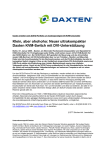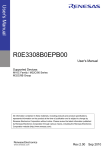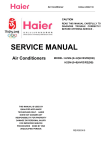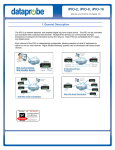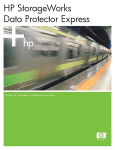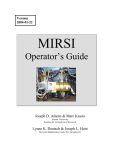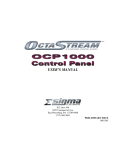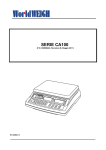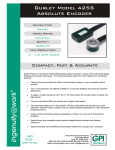Download JVC Switch K3-R User's Manual
Transcript
K3 Series 1U Rack Mount A/B Switches General Description The K3 Series A/B Switching system provide up to 3 AB switches in a 1.75 in rack mount chassis for 19” Equipment cabinets. Each switch allows a common circuit (COM) to be switched to either of two circuits, designated A and B. The switches can be controlled locally with a front panel toggle switch and remotely by; contact closure, or thru a Serial port and Ethernet connection using Telnet, SNMP, or a Web browser. Modular System The K3 System consists of the K3 Chassis, Model K3-R and Power, Control and A/B Switch options. The following table illustrates the available K3 components available at the time of printing. Additional options may be available; contact Dataprobe. SKU Model Description Base 1150100 K3-R K3 Chassis Control 1340062 C-AB-16-R IP and Serial Control Card, Individual Switch Control 1340065 C-AB-1-R IP Control Card, Gang Control 1340063 G-AB-1-R Gang Expansion or GPI Control 1930077 PS-R1-WRI Internal AC Power Supply 100-240VAC 1930078 PS-R1-48 Internal -48VDC Power Supply 1930079 PS-R1-224 Dual External 24VDC Power Supply. For use with External AC Supply 1930076 PS-WRI-4 External A/C Power Supply 1110100 AB-R-D25 25 Pin D Subminiature, all 25 pins supported 1110101 AB-R-RJ8 8 Wire Modular Jacks; All leads switched. Supports RJ48C, RJ48S, RJ45 and all 8 position modular jack specifications, up to16Mhz 1110102 AB-R-2RJ8 Same as above with two ganged switches. 1110103 AB-R-NET 8 Position, 8 Wire Modular Jacks; All leads switched; Supports 10/100/1G Ethernet Network specifications. 1110104 AB-R-T50 50 Pin Telco (Amphenol) connector. All 50 Leads Switched. Dual Height Switch must be in Slot 1 1110105 AB-R-M34 34 Pin M Type (V.35) connector. 23 leads switched. Dual Height Switch must be in Slot 1 1920028 AB-FP Blank Panel for unused A/B Slots. Required for FCC and CE marking Power A/B K3_system_v070607e Technical Support: 201-934-5111 Main: 201-934-9944 [email protected] Website: dataprobe.com K3 System Page 2 Installation & Operation K3 Chassis The K3 Chassis holds the Power, Control and A/B Switch modules for the K3 system. It installs in a standard 19” EIA equipment cabinet, requiring 1.75” (1U) of rack height. K3 systems are preconfigured and tested in the factory. All Control, Power and Switch modules are pre-installed. Manual Switch Control A front panel momentary toggle switch for each A/B Switch installed allows local manual control. AB Switch Status Indication Two front panel LED's for each A/B Switch installed indicates switch position A or B. Individual switch status can also be monitored thru the Network or Contact control interface. Remote alarms or displays can be controlled by the status signal of each switch, which are provided as form C relay contacts when the Contact interface is installed. Power Supply Status Indication The K3 has two LED indicators that display the current status of two power supply sources. These are designated PS-1 and PS-2. LED ON Indicates the power supply source is connected. PS-1 Internal Power Supply Module, or External Power Supply #1 PS-2 External Power Supply #2 K3 System Page 3 The K3 series supports both internal and external power supplies. Internal power modules are available to support worldwide A/C power, -48VDC and +24VDC power requirements. External power supplies provide redundancy either when used in pairs, or when combined with an internal module. Power Supplies Modules The K3 Series can be powered by several types of power sources using four types of power supply options; 90- 240VAC 50/60Hz Internal module, 90 -240 VAC External module, 48 VDC Internal module and 24 VDC direct. Combinations of 1 internal + 1 external supply or 2 external supplies can be used for redundant power applications. Dataprobe offers the following internal supply modules for the K-16 series: 193007 7 PS-R1-WRI Internal AC Power Supply 100-240VAC 193007 8 PS-R1-48 Internal -48VDC Power Supply 193007 9 PS-R1-224 Dual External 24VDC Power. For use with External AC Supply Power Supply 1930077 Power Supply 1930078 Converts 110/ 220 /240 VAC to 24VDC Single Slot Redundant Capable Converts 48 VDC to 24VDC Single Slot Dual Redundant Capable Input Power Nominal : 120/240 VAC 50/60 Hz Range : 100 - 240 VAC Watts: 50 Fusing: 2 A Input Power 100 - 240 VAC 1.4A, 50-60 HZ ALARM Environmental Operating: 0 C - +65C ! REFER TO MANUAL Nominal : 48 VDC Range : 42 - 60 VDC Watts: 75 Fusing: 2.5 A INPUT 48VDC, 2A. MAX ALARM Environmental Operating: 0 C - +65C Physical Physical AC Input connector: IEC 320 (C14) on rear panel DC Input Connector: Screw Terminal Mating Connector Supplied. Alarm / Expansion connector: 9 pin d-Sub Contact Ratings: 1A @ 24VDC res. Alarm / Expansion connector: 9 pin d-Sub Contact Ratings: 1A @ 24VDC res. K3 1RU AB Switch Page 4 Alarm Connector Alarm Connection on each power supply provides status information on the condition of the supply. 9 Pin Dsubminiature Pin 6 NO Pin 7 COM Pin 8 NC Pin 6 shorts to Pin 7 when the Power Supply is Non-Operational Pin 8 shorts to Pin 7 when the Power Supply is Operational Power Access Panel 1930079 Provides for connection of two K-16-XPS Power Supplies Input Power Nominal : 24VDC Range : 20 – 30 VDC Fusing: 2 A Slo-Blo Physical DC Input Connector: Connector: Molex 41995 Mating Connector Kit # 1940164 Mating cable supplied with K-16-XPS PS1 PS2 K3 24VDC External PS Panel Rear View External Power Supplies 1930076 Power Input 100-120/200-240 50-60Hz IEC320 Male. Power Input cord supplied for North America. Power Output +24VDC 4.5A, Connector Molex 41995. 6 5 4 3 2 1 1, 2 +24VDC 5, 6 GND 3, 4 N.C. K3 1RU AB Switch Page 5 Control Modules The K3 Series AB Switch System is available with three types of control modules; Network, Contact Closure, or Gang Control Expansion. One of three control options shown below will be installed in the chassis for remote control of the installed AB switch cards. C-AB-16-R C-AB-16-R provides remote control through In-Band and Out-of-Band operation thru Ethernet TCP/IP and Serial connections. WEB Telnet SNMP Serial TCP Messaging Through a web browser interface, you can access the control card, obtain current status information and operate the A/B Switches Through a telnet client, you can access the control card, obtain current status information and operate the A/B Switches. This is also the method for setting configuration parameters of the card The system can be managed by SNMP through standard management software. Dataprobe provides a private MIB. The serial port on the C-AB-16-R provides direct terminal access or via modem. The A/B Cards are controlled either by a menu selection or by command line strings (escape code sequences). Menu selections are ideal for easy operator interface and the escape code sequences streamline automated control. A direct TCP messaging protocol is supported for direct computer control of the A/B switching system Installation The Control interface is located in the lower middle section on the rear of the K3 chassis. The C-AB-16-R controller provides the following connections: 10base-T Ethernet. (C-AB-16-R only) Network connection for access to the C-AB-16-R card. C-AB-16-R Rear View Serial Port. RS-232 port for out-ofband access to the C-AB-16-R card. Gang Expansion. RJ11 connection for connection to additional card nests for large gang switching applications. External Power Input. Connection for external power supply K-16-XPS-R for single or dual redundant power. Mating Connector kit # 1940164 Gang 10base-T Ethernet Serial Port PS2 External 24VDC Gang Expansion Power Input (optional) K3 1RU AB Switch Page 6 Serial Port The Serial Port on the control card is a 9 pin male connector, configured as a DTE. The following pins are used. The following chart illustrates the pin out of the D9 connector and the connection required to an external modem with a D25 pinout. D9 Pin Abbreviation Full Name Modem D25 Pin Pin 2 RD Receive Data Pin 3 Pin 3 TD Transmit Data Pin 2 Pin 5 SG Signal Ground Pin 7 Pin 9 RI Ring Indicator Pin 22 For connection directly to a terminal, a Null Modem cable is required. C-AB-16-R D9 Pin Terminal D9 Pin Pin 3 Pin 2 Pin 2 Pin 3 Pin 5 Pin 5 Configuration – C-AB-16-R Configuration of the The C-AB-16-R involves the following steps: • Setting The C-AB-16-R 's IP Address • Setting additional configuration parameters using Telnet Setting I/P Address The C-AB-16-R comes with factory installed IP address 192.168.1.254. In most cases this will need to be changed. Consult your Network Administrator to determine the appropriate IP address. There are several methods to change the IP address. • ARP • Telnet • Serial Port • setip.exe program, available from Dataprobe’s web site To set the IP address, the hardware (MAC) address must be known. This address is located on a label on on the C-AB-16-R printed circuit board. The syntax for the MAC address is: nn-nn-nn-nn-nn-nn K3 1RU AB Switch Page 7 Setting the IP address using ARP To set the IP address using ARP, connect the jack marked 10Base-T to your local Ethernet network and apply power to the unit. The computer used to set the IP address must be on the same physical network as the C-AB-16-R . ARP does not work across switched or routed networks. Windows (98 and Later) 1. Open a DOS window. 2. Type the following command: arp -s <IP Address> <MAC Address> Where <IP Address> is the desired IP address (in dotted decimal) for the C-AB-16-R and the <MAC address> is the MAC Address of the C-AB-16-R . The MAC Address is located on a label on the rear panel of the card. Example: arp -s 63.211.86.165 00-50-c2-05-01-c1 <enter> |--- new IP addr. ---| |------- MAC addr. ------| 3. Ping the C-AB-16-R to program the IP address into the C-AB-16-R . Type: ping <IP Address> If the ping command returns “host not responding” 4 times then the address has not been programmed properly, or the IP or MAC Address is incorrect. In either case redo step 2. If the problem persists, contact the Dataprobe Tech Support Hot Line. 4. Delete the entry from the ARP cache by typing: arp -d <IP Address> 5. Ping the C-AB-16-R to confirm that it has been programmed. If the card fails to respond, repeat steps 2-4 above. If the problem persists contact the Dataprobe support hotline. Unix, Linux Consult your systems administrator for information on setting an IP Address using ARP. The unit should be pinged after the IP Address has been set to confirm proper operation. Setting IP Address with Telnet For initial setup, the computer used must use the same network segment as the default IP Address, or current IP address. (192.168.1.xxx) If this is not the case, use one of the other methods. To connect to the C-AB-16-R using telnet, run your telnet client program (provided with your operating system) and connect to the IP address as set in step one above. For Windows: Select Run…Telnet Connect…192.168.1.254 (or the current IP address) As soon as you connect the following message will be displayed: K-16 Ver 4.00 Please Enter The Password Password > The factory default password is: PASS K3 1RU AB Switch Page 8 This password is case sensitive and can be changed in the setup process. In telnet, the The C-AB-16-R has a security timeout feature. After 2 minutes of no activity, The C-AB-16-R will automatically terminate the session. Should this occur, simply re-connect and re-enter the password. K-16 Set Location 1. New York 1 2. New York 2 3. Philadelphia 4. 5. 6. 7. 8. 9. 10. 11. 12. 13. 14. 15. 16. A B A A A A A A A A A A A A A 1-16. Operate Switch A. All to 'A' B. All to 'B' S. Setup X. Exit K-16> S Select S to access the setup Menu K-16 1. 2. 3. 4. 5. 6. X. Set Location Location Name Card Setup Password Com Port Escape Response IP Settings Exit K-16> Setup Menu Set Location 9600 8n1 No K3 1RU AB Switch Page 9 Select 6 for IP Settings. The IP Settings Menu appears: IP Settings 1. 2. 3. 4. 5. 6. 7. 8. 9. A. B. C. D. X. IP Address Subnet Gateway Web Port Telnet Port Message Port MTU Write Community Name Read Community Name SNMP Manager 1 SNMP Manager 2 SNMP Manager 3 SNMP Manager 4 Exit 192.168.1.42 255.255.255.0 0.0.0.0 80 23 9100 1024 private public 192.168.1.97 0.0.0.0 0.0.0.0 0.0.0.0 K-16> Enter the IP address, Subnet Mask and Gateway in Dotted Decimal Format. Setting IP address via Serial Port The serial port uses the same menu sequences as the Telnet method described above. Connect a terminal directly to the C-AB-16-R serial port. Send an Enter keystroke to start the session. The serial port default settings are 9600bps, 8 data bits, no parity, one stop bit. These setting can also be changed via the menus. Setting IP Address with setip.exe Utility setip.exe is available from Dataprobe’s website at http://www.dataprobe.com/files/control/setip.exe. Download this windows program and run it on any computer on the same physical network segment as the control card. Enter the MAC address and desired IP address and press SetIP. Setting other Parameters Via the Serial Port (or telnet on the C-AB-16-R) , all other configuration parameters can be set for the CAB-16-R . These setting are made from the Setup Menu, as described in the section 3.1.3 above. Location Name: Enter a 1-20 character name to identify the system. This name appears at the top of each telnet screen and web page. Card Setup: This allows setting of parameters for individual A/B cards in the system. Each card can be named, up to 20 characters, and can be enabled or disabled. Disabling a card hides its status from web and telnet screens. This should be used where no card is installed, to make reading the screens easier. NOTE: Only the 1st three AB card slot positions of the 16 displayed are used in the K3. Displayed Slots 4 thru 16 are non functional. Password: A password from 1 to 15 characters is needed for access to the system. Re-enter the old password then enter the new password twice as prompted. K3 1RU AB Switch Page 10 Com Port: Set the Baud Rate and Character Format for the serial port. Baud rate choices are 9600, 19200, and 38400. Character format choices are 8N1, 7E1 and 7O1 (databits, parity, stop bit). The Default Serial Port Parameters are 9600, 8 Data Bits, No Parity, One Stop Bit (9600,8,N,1) Escape Response: This selects Yes or No for escape code responses. See section 3.4.3 on escape code control IP Settings IP Settings 1. 2. 3. 4. 5. 6. 7. 8. 9. A. B. C. D. X. IP Address Subnet Gateway Web Port Telnet Port Message Port MTU Write Community Name Read Community Name SNMP Manager 1 SNMP Manager 2 SNMP Manager 3 SNMP Manager 4 Exit 192.168.1.254 255.255.255.0 0.0.0.0 80 23 9100 1024 private public 0.0.0.0 0.0.0.0 0.0.0.0 0.0.0.0 K-16> IP Address, Subnet Mask and Gateway: Enter the appropriate information in dotted decimal format (xxx.xxx.xxx.xxx). If you are unsure of the entries, consult your network administrator. Web Port, Telnet Port, Message Port: These three settings determine the port assignment for the different TCP protocols used to communicate with the control card. Standard port assignments for these protocols are: WEB: 80 Telnet: 23 Message: 9100 If you change these assignments, you will need to specify them when you connect to the C-AB-16-R . For example if the IP address of the C-AB-16-R is 192.168.1.254 and you have changed the web port to 8800, then you would need the following URL to access the C-AB-16-R : http://192.168.1.254:8800 K3 1RU AB Switch Page 11 Note: After changing the IP Address, Web Port, Telnet Port or Com Port parameters, it is necessary to reboot the C-AB-16-R. By removing power to the the K3 chassis momentarily and then reconnecting the power source. Neither operation will alter the switch positions of any A/B Card in the Nest. MTU: Maximum Transmission Unit. Set the MTU from 100 to 1024. The default of 1024 should not be changed unless required by network architecture. Read and Write Community Names: These settings are for use with SNMP managers only. Set the names as appropriate for your SNMP configuration. SNMP Managers: Set up to four SNMP managers that will receive SNMP TRAPs. Other SNMP managers will be able to manage the system. Operation Remote control of each or all A/B Cards is accomplished using either TCP/IP protocols for Web browser (http) , Telnet, or direct TCP messaging. Each card in the chassis can be operated independently, or all 3 A/B cards can be operated simultaneously. In all cases, switch control is password protected. Web Browser Operation To access the K3 using any web browser, point your browser to the IP address of the C-AB-16-R card. If the IP address is the default 192.168.1.254 then enter in the web browser address bar: http://192.168.1.254 You may wish to bookmark this location and rename the bookmark for easy reference. You will be prompted for a User Name and Password. The User Name is not used, and any or no characters can be entered there. Enter Password as programmed in the setup menu system. The default password is PASS. Please guard your password safely. If the password is forgotten, contact Dataprobe Tech Support. Upon entering the correct password, the main page will be displayed. K3 1RU AB Switch Page 12 The web page shows the current status of each enabled card in the chassis. It also displays the status of the two power supplies in the lower right corner. To operate one or more switch cards: Select the desired A/B Card(s) using the checkbox next to the card and then click on the large A or B button under Switch Control. The screen will refresh with the new card status shown. Buttons for Select All and Select None assist in making selections. The Web page will not automatically refresh if the A/B cards are controlled using the manual switches. In the event that switch cards are operated by front panel toggle switches or other external control, a Refresh button is provided. Click on this button to view the most current status information. K3 1RU AB Switch Page 13 If cards are not installed in the system, their status will be reported as Position A. To avoid confusion, use the Disable feature in the Telnet Setup for unused card slots. When cards are disabled, their name will continue to appear on the web page or telnet screen, however, their status will be indicated as displayed in the screenshot below. Note: Card 4 – 16 are not available in the K3 system and have been disabled. To simultaneously switch all cards in the chassis, click on either the Gang A or Gang B buttons. The checkboxes need not be used for this operation. K3 1RU AB Switch Page 14 A logout button is provided. Click this button to be instantly logged out. There is an automatic logout function if there is no activity for two minutes. You can also just close the browser; however you will not be able to log back in for two minutes. Telnet and Serial Port The menu system of the C-AB-16-R is the same for Telnet and direct serial access. For Telnet: Enter the IP address of the C-AB-16-R into your Telnet application program For Serial Direct Terminal Connection: press the Enter Key For Serial Connection via Dial-up Modem: Establish the dial link, then press the Enter Key. After entering the correct password, the main screen is displayed K-16 1. 2. 3. 4. 5. 6. 7. 8. 9. 10. 11. 12. 13. 14. 15. 16. Set Location New York 1 New York 2 Philadelphia Baltimore Atlanta Charlotte Tampa Chicago Cleveland St. Louis Minneapolis Dallas Seattle Portland San Francisco Los Angeles A B A A A A A A A A A A A A A A 1-16. Operate Switch A. All to 'A' B. All to 'B' S. Setup X. Exit K-16> The screen shows all enabled cards and their current position A or B Enter any card number 1-3 to operate that card; A or B to switch all cards to that position. Enter S to access the setup menus (see section 3.2.5 for setup details) Enter X to logout of Telnet. Card slots that have been disabled will not report any status. NOTE: Only the 1st three AB card slot positions of the 16 displayed are used in the K3. Displayed Slots 4 thru 16 are non functional. K3 1RU AB Switch Page 15 SNMP Manager Control The C-AB-16-R allows for management via SNMP. The private MIB is available from the Dataprobe Web Site at: http://www.dataprobe.com/files/switch/k16/k16.mib MIB Outline and MIB Definitions can be found in Appendix A. Command Line and Direct TCP Messaging The C-AB-16-R can be controlled via command line messages sent either over the serial port or using TCP messaging over the Ethernet port. This allows streamlined communication between the C-AB-16-R and network management systems or computer based monitor and control systems. Programming support is available. Contact Dataprobe Applications Engineering. Making Connection via Ethernet and Serial The C-AB-16-R uses the TCP (Transport Communication Protocol) to communicate with the client PC. To use the C-AB-16-R , establish a TCP connection (Stream Socket) to the C-AB-16-R . Be sure to use the Port assigned to the C-AB-16-R , either Port 9100 or the port assigned through the Setup Menus. Once connected use the Send() function to send the commands to the C-AB-16-R and the Recv() function to receive the C-AB-16-R ’s response. For the CP-K16-R or the serial port of the C-AB-16-R , connection via the serial port requires only setting the computer to the proper baud rate and character format. Command Syntax <esc><password><^a><card><^b><command><cr> Where: esc password ^a card ^b command = = = = = = cr = The ASCII escape character (0x1b) The C-AB-16-R password in ASCII (case sensitive) The ASCII control 'a' character (0x01) The number of the card to be changed, with or with out leading 0's (a or A = all) The ASCII control 'b' character (0x02) The command to be executed: a or A - Switch selected card to A b or B - Switch selected card to B q or Q - Display the status of the selected card The ASCII Carriage Return (0x0d) The < and > in the syntax above are only to delineate the control characters and should not be sent. Example: To switch card 7 to B send <esc>PASS<^a>7<^b>B<cr> Response Syntax The syntax for the command response is. <card><status><cr> Example: 01A card status = = The number of the card. The status of the card either A, or B. K3 1RU AB Switch Page 16 cr = The ASCII carriage return character If the queried card has been disabled then no response will be transmited. In response to the Query All command, 16 response messages will be sent. All invalid commands will be ignored. No response even when responses are enabled. Gang Control Expansion G-AB-1RR Gang Expansion Card The G-AB-1RGang Expansion Card provides input and output of gang control, allowing for simultaneous switching of multi-chassis systems. Connection is also provided for external power input from the K16XPS or similar +24VDC source. Installation The Gang Expansion interface is located in the lower middle section on the rear of the K3 chassis. Connection between G-K16X units or connection from C-AB-16-R or other control card is made using 6 wire connection modular jack cords. ( RJ11 / RJ12 type ) Expansion Connector Pinout Pin Designation 1 & 6 Ground 2 & 5 Switch to B 3 & 4 Switch to A Gang Out Gang In Alarm G-K16x Rear View To control the system, momentarily short either Switch to A or Switch to B to Ground. PS2 K3 1RU AB Switch Page 17 A/B Switch Modules The K3 Rack Mount AB Switching System can be factory configured with up to 3 AB switches of any of the following interfaces plus one control interface and power supply configuration. Some switch interfaces occupy 2 slots – SW1 & SW2 Frame Ground Switching 1 (D9, 15 and 25 model Only) Jumper selection allows Pin 1 Frame Ground to be either switched or tied together and unswitched. Pin 1 can also be tied to the Frame of the Chassis, or left isolated from the chassis. Signal Ground Switching (D9, 15 and 25 model Only) SW'D FG COM ISO 1 1 A B COM Shown In Factory Default: Ground Switched & Isolated An additional set of jumpers provides the same switched/common, isolated or grounded for Signal Ground. These jumpers control Pin 7 in the D25 model and Pin 5 in the D15 and D9 models. The circuit is the same as shown above replacing Pin 1 for the correct pin and SG Signal Ground for FG, Frame Ground Signal Ground Switching An additional set of jumpers provides the same switched/common, isolated or grounded for Signal Ground. These jumpers control Pin 7 in the D25 model and Pin 5 in the D15 and D9 models. The circuit is the same as shown above replacing Pin 1 for the correct pin and SG Signal Ground for FG, Frame Ground. Indicators Two Red LEDs indicate Switch status A or B. LED's are driven by extra relay contacts. Manual Switches Manual toggle switch on each card. These are momentary switches. Relays Sealed Telephone relays. Gold clad contacts. Maximum Contact Current: 2 Amps @ 30 VDC Special DS-3 module: Hi Freq. 45 Mhz, 55db Isolation. K3 1RU AB Switch Page 18 Specifications Switch Interfaces D25 Three 25 Pin D Subminiature, Female Connectors. 25 leads switched. Option for Pins 1 and 7 common and unswitched. RJ8 Three 8 position 8 wire RJ type Modular jacks, Rear Panel/Card Edge. All 8 leads switched. Support all RJ Configurations up to 16 Mhz. NET: Three 8 position 8 wire RJ type shielded modular jacks, Rear Panel/Card Edge. Supports 10/100/1G Ethernet Interfaces. DS3 Same as above but with special Dual BNC Module. Individual transmit and receive circuits 45 Mhz . T50 50 pin Telco (Amphenol, Champ) connectors. Common = Male, A and B are Female. All 50 leads switched. V35 34 pin Winchester Female connectors 19 Leads Supported. Physical Rack Mount 19” Wide x 6.0” Deep x 1.75” High. K3 1RU AB Switch Page 19 MIB Outine NOTE: The K3 Series AB Switch System use the same network control interface as our larger K16 Series. The same SNMP MIB interface is used with same values and commands .Only the 1st three AB card slot positions of the 16 displayed are used in the K3. Displayed Slots 4 thru 16 are non functional. Mib Tree iso (1) org (3) dod(6) internet(1) private(4) enterprises(1) dataprobe(1418) dpAgent(1) k16SwitchControl(1) k16RackName(1) k16CardTable(2) k16CardEntry(1) k16CardIndex(1) k16CardName(2) k16CardPosition(3) k16CardEnable(4) k16GangControl(3) k16PowerSupply1(4) k16PowerSupply2(5) Traps ps1Failed ps1Ok ps2Failed ps2Ok switchChanged syncStatus K3 1RU AB Switch Page 20 MIB Definitions k16RackName 1.3.6.1.4.1.1418.1.1.1 This read/write variable is the name of the k16 nest. This variable can be programmed either via SNMP, Telnet or via serial port. It can contain printable characters and MUST not exceed 20 characters in length. k16CardTable 1.3.6.1.4.1.1418.1.1.2 This variable is not directly accessible. k16CardEntry 1.3.6.1.4.1.1418.1.1.2.1 This variable is not directly accessible. k16CardIndex 1.3.6.1.4.1.1418.1.1.2.1.1.k16CardIndex The card index. This is a 0 based index so 0 is card 1 and 15 is card 16. k16CardName 1.3.6.1.4.1.1418.1.1.2.1.2.k16CardIndex This read/write variable is used to set or get the name of an individual A/B card. The card name can only contain printable ASCII characters and MUST not exceed 20 characters in length. k16CardPosition 1.3.6.1.4.1.1418.1.1.2.1.3.k16CardIndex This read/write variable can be used to set or get the position of any of the 16 A/B cards individually. This variable uses an enumerated integer where: 1=a 2=b 3 = disabled 4 = invalidCardIndex The values 3 and 4 cannot be used in the set command. These are returned by the get and set commands when appropriate. k16CardEnable 1.3.6.1.4.1.1418.1.1.2.1.4.k16CardIndex This read/write variable is used to set or get the enabled/disabled status of an A/B card. It uses an enumerated integer where: 1 = enabled 2 = disabled 3 = invalid index The value 3 cannot be used in the set command. It is returned by both the set and get commands when the card index is invalid. k16GangControl 1.3.6.1.4.1.1418.1.1.3 This read/write variable is used to set the position of all cards in the nests. It uses an enumerated integer where: 1=a 2=b 3 = writeOnly The value 3 is always returned form both the get and set commands to alert the operator that there is no data for this command to return. K3 1RU AB Switch Page 21 k16PowerSupply1 1.3.6.1.4.1.1418.1.1.4 This read only variable returns the current status of the power supply 1 as an enumerated integer where: 1 = ok 2 = failed. k16PowerSupply2 1.3.6.1.4.1.1418.1.1.5 This read only variable returns the current status of the power supply 2 as an enumerated integer where: 1 = ok 2 = failed. k16Sync 1.3.6.1.4.1.1418.1.1.6 This read only variable returns the status of the synchronization channel (special models only) as an enumerated integer where: 0 = ok 1 = fail Trap Definitions ps1Failed specific-1 This trap is sent when ever power supply 1 fails. It carries not variable bindings. ps1Ok specific-2 This trap is sent when ever power supply 1 returns to serves. It carries not variable bindings. ps2Failed specific-3 This trap is sent when ever power supply 2 fails. It carries not variable bindings. ps2Ok specific-4 This trap is sent when ever power supply 2 returns to serves. It carries not variable bindings. switchChanged specific-5 This trap is sent when ever any or multiple switches are changed by any means. This trap will contain a variable binding for each card in the nest that has changed. syncStatus specific-6 This trip is sent when ever the status of the nest synchronization changes. It will contain the k16Sync variable. Only available in special models. K16 Series Standalone/ -R1 Mount Page 22 TECHNICAL SUPPORT, RETURNS and WARRANTY Dataprobe Technical Support is available 8:30AM to 5:30PM ET to assist you in the installation and operation of this product. To obtain Technical Support call our Tech Support Hotline at 201- 967-8788, or Email us at [email protected]. Please have the following information available when you call: • • • • Model of Product Serial Number Data of Purchase Name of Seller (if other than Dataprobe) If you purchased this product through an Authorized Dataprobe Reseller, you should contact them first, as they may have information about the application that can more quickly answer your questions. WARRANTY Seller warrants this product, if used in accordance with all applicable instructions, to be free from original defects in material and workmanship for a period of One Year from the date of initial purchase. If the product should prove defective within that period, Seller will repair or replace the product, at its sole discretion. Service under this Warranty is obtained by shipping the product (with all charges prepaid) to the address below. Seller will pay return shipping charges. Call Dataprobe Technical Service at (201) 967-8788 to receive a Return Materials Authorization (RMA) Number prior to sending any equipment back for repair. Include all cables, power supplies and proof of purchase with shipment. THIS WARRANTY DOES NOT APPLY TO NORMAL WEAR OR TO DAMAGE RESULTING FROM ACCIDENT, MISUSE, ABUSE OR NEGLECT. SELLER MAKES NO EXPRESS WARRANTIES OTHER THAN THE WARRANTY EXPRESSLY SET FORTH HEREIN. EXCEPT TO THE EXTENT PROHIBITED BY LAW, ALL IMPLIED WARRANTIES, INCLUDING ALL WARRANTIES OF MERCHANT ABILITY OR FITNESS FOR ANY PURPOSE ARE LIMITED TO THE WARRANTY PERIOD SET FORTH ABOVE; AND THIS WARRANTY EXPRESSLY EXCLUDES ALL INCIDENTAL AND CONSEQUENTIAL DAMAGES. Some states do not allow limitations on how long an implied warranty lasts, and some states do not allow the exclusion or limitation of incidental or consequential damages, so the above limitations or exclusions may not apply to you. This warranty gives you specific legal rights, and you may have other rights which vary from jurisdictions to jurisdiction. WARNING: The individual user should take care to determine prior to use whether this device is suitable, adequate or safe for the use intended. Since individual applications are subject to great variation, the manufacturer makes no representation or warranty as to the suitability of fitness for any specific application.






















